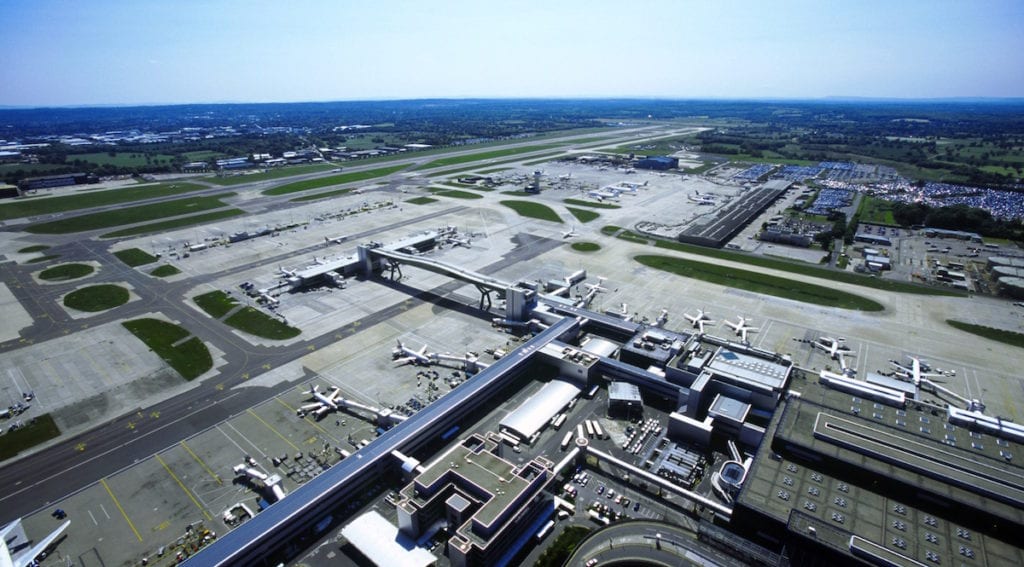
An RTCA subcommittee is working on developing a consensus standard that details unmanned aircraft detection and mitigation standards, around airports, such as London Gatwick Airport, pictured here, where an incident involving a drone shutdown operations and cancelled hundreds of flights during an incident in December 2018. Photo: London Gatwick Airport
A Radio Technical Commission for Aeronautics (RTCA) subcommittee is working toward development of a standard for detecting small drones around airports, which will help buyers and users of drone security systems to know if the detection component will perform as intended.
RTCA stood up a counter unmanned aircraft system (UAS) special committee in December to begin work on the detection standard after being approached by several government organizations such as the Federal Aviation Administration and the Departments of Defense and Homeland Security to help the U.S. sort out drone security challenges, Al Secen, vice president of Technology and Standards with the association, said in an interview.
The standard will address questions like how quickly a target should be acquired, how small of a target should be detected, how it will be tracked through “violent maneuvers that a typical airplane wouldn’t go through,” Secen said.
Currently, government agencies like the FAA, DoD and DHS are being approached by industry with their sensors and solutions, but the government doesn’t know if something is “good enough” or “what is bad,” Secen said. The DoD hosts “Grand Challenges” to evaluate sensors and technologies in certain scenarios, but with detection standards, “all you have to do is say, ‘I’ve developed this against this standard and it meets the standard,’ and it sort of level sets everybody in the room. This is how it’s going to perform and this is why it’s performing this way.”
The “impetus” for moving forward on the drone detection standard was the temporary shutdown in December 2018 of hundreds of flights into and out of Gatwick Airport near London, Secen said in the July 6 interview done virtually. After the incident, the various government agencies approached RTCA about detection standards development, he said.
That incident costs airlines tens of millions of dollars and, since then, small drones operating near and in airspace around airports have become an occasional nuisance for airport operators worldwide, causing flight delays, stranding passengers and raising concerns about potentially fatal collisions with passenger aircraft.
“[We] Need proper detection to avoid economic loss and the travel disruptions we’ve had,” Max Fenkell, co-chair of the RTCA Special Committee-238 Counter UAS, said during the interview. Fenkell is the director for Unmanned and Emerging Aviation Technologies at the Aerospace Industries Association, a trade association representing the aerospace and defense industry.
RTCA works with various stakeholders to develop consensus standards across the wide range of aviation modernization issues.
The eventual drone detection standard will be “technology agnostic,” Fenkell said. Secen added that “We ensure a level playing field for everyone. The market will determine which solutions are better.”
So far, the special committee, which includes a broad range of members from academia, government and industry, including representatives from Europe, has been “incredibly active,” Fenkell said, despite grappling with impacts from the ongoing COVID-19 pandemic and having to meet virtually across time zones between Germany and California.
The committee, which is working jointly with RTCA’s European counterpart EUROCAE, is putting together its first product, an Operational Services and Environmental Definitions (OSED) document, which Secen described as being akin to a concept of operations (CONOPS).
The OSED will “describe the ecosystem that the standard is going to be employed,” he said. “It allows people to say, ‘I can see my application, my agency, my offering in this OSED. I see where I fit in the overall CONOPS in this space.’”
The OSED is “foundational” to the eventual standard, which RTCA calls a Minimum Operational Performance Standards (MOPS).
This article was originally published in Defense Daily, a sister publication to Avionics, it has been edited. To read the full version, click here.